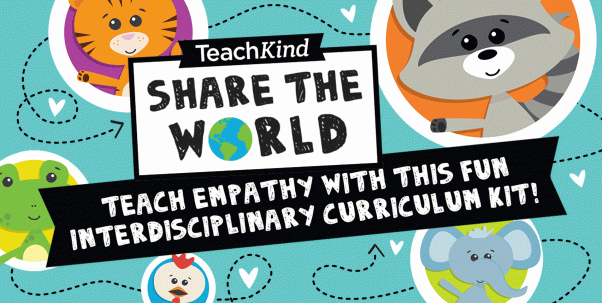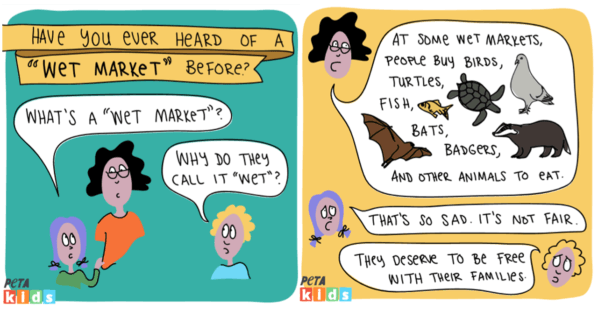Animal-Free Classrooms? PETA’s Hopes for Education in the Age of COVID-19
What will classrooms look like this fall? Classroom teaching—if it takes place at all—will look very different when the next school year begins. As school administrators consider making sweeping changes to classroom learning, PETA is pushing teachers to tell school officials that animals are individuals with unique needs and wants, not disposable “teaching tools” for children.

Animals Don’t Belong in Schools—Here’s Why
When the school year resumes, not a second can be wasted on cruel and unnecessary classroom practices involving animals. Whether teaching students takes place in person, virtually, or in a hybrid setting this fall, teachers must be the voice of reason at their schools. It’s vital to teach students that animals—no matter their size—feel the same emotions that they do.
Teachers will already have to begin the school year making up for lost instructional time. They will also be responsible for the social and emotional well-being of students, many of whom will be struggling after prolonged school shutdowns. To create a healthy, safe classroom environment, teachers must protect animals from needless suffering and show students the importance of consent and respect. The guidelines below can help.
An End to Classroom Dissection Projects
Cutting up dead frogs, pigs, and cats—each of whom wanted to live—has never been essential, let alone acceptable. Modern science curricula and standards no longer require—or even refer to—animal dissection, and not a single medical school in the U.S. or Canada requires medical students to dissect animals. No student enrolled in biology or anatomy courses has to cut apart animals in order to learn about their organs or compare them to those of humans.
Digital dissection programs are superior in a number of ways—they save animals, eliminate student exposure to toxic chemicals such as formaldehyde (a carcinogen), save schools money, and often include helpful features like spoken instructions and built-in assessments. Teachers can also use 3-D paper models that allow kids to study biology and get creative at the same time.
Boosting Students’ Resilience With Humane Education
When life as we knew it came to a screeching halt this past spring, we all felt stressed, confused, and scared. Young students—many of whom thrive in the structured environment of school and need meaningful interactions with their peers to grow and learn—bore the brunt of this sudden but necessary upheaval.
Most kids care about animals, so teachers can use that natural tendency to help them develop social and emotional core competencies. That way, they can deal effectively and ethically with life’s challenges and contribute to their communities in a positive way for years to come.

With so much going on in the world right now, it’s important for students to know that some things are still within their control—like how they treat others, including animals.
The Problem With Chick-Hatching Projects
Ostensibly designed to teach students about life cycles, chick-hatching projects involve placing fertilized chicken eggs in classroom incubators until they hatch—but they totally miss the mark.
Even before chicks are born, they need their mothers, who carefully rotate the eggs up to 30 times a day in order to maintain the proper temperature, moisture, and positioning. Chicks grown in an incubator can become sick and deformed as they develop, because their needs aren’t met during incubation. And if they hatch at night, on a weekend, or amid the chaos of another sudden school shutdown, no one will be around to care for them.
Many educators have stopped doing chick-hatching projects to teach embryology and developmental biology because of concerns about animal welfare and student safety. According to the Centers for Disease Control and Prevention (CDC), chicks can look healthy but still harbor deadly bacteria like E. coli and salmonella. Children who hold, cuddle, or kiss them—or even touch things around the birds’ living area—can be exposed to the bacteria. The CDC warns that young children are especially at risk for illness because their immune systems are still developing and because they’re more likely than others to put their fingers or other things into their mouth.
Any school that conducts chick hatchings is a potential breeding ground for these and other pathogens, including West Nile virus, which domestic fowl can contract. As we work to combat a global pandemic, the last thing that we should be doing is compromising students’ immune systems by introducing dangerous pathogens into the classroom.
The Rise of Virtual Field Trips
Traditional class field trips will likely remain off the table during the COVID-19 pandemic, but that doesn’t mean students can’t explore the world around them safely and humanely.
Students can observe animals in their natural habitat without disturbing them or leaving home with one of the many live animal cams available online. From watering holes in Africa to the Arctic tundra, live video feeds allow students to experience what life is like for animals on their own terms, not ours.
Virtual field trips not only excite students and teach them about the natural world but also instill in them an important lesson—that animals are not ours to hold captive in roadside zoos, marine parks, or circuses and use for our entertainment.
No More Classroom ‘Pets’
Keeping animals as classroom “pets” is a bad idea. Neglect (intentional or not) and abuse are widespread. Animals have extensive and complex needs—which are unlikely to be met in a busy, bustling, and brightly lit classroom setting. In addition, animals can trigger students’ allergies and asthma.
Thankfully, there are countless fun, creative, and interesting ways to teach your students about responsibility, animal-companion care, life cycles, and animal science that won’t put anyone’s well-being at risk.
Teaching Students the Origin of COVID-19 and Other Deadly Diseases
As COVID-19 continues to grip the world, students are very likely questioning just how we got here. Discussing this major event and the role that exploiting animals plays in outbreaks of infectious diseases can expose them to important new facts and help them synthesize information about events that might otherwise seem overwhelming. This will allow them to draw their own conclusions and make informed decisions.

Students of all ages must be taught to connect the dots between killing and eating animals and the prevention of future pandemics and explore possible solutions, such as going vegan.

